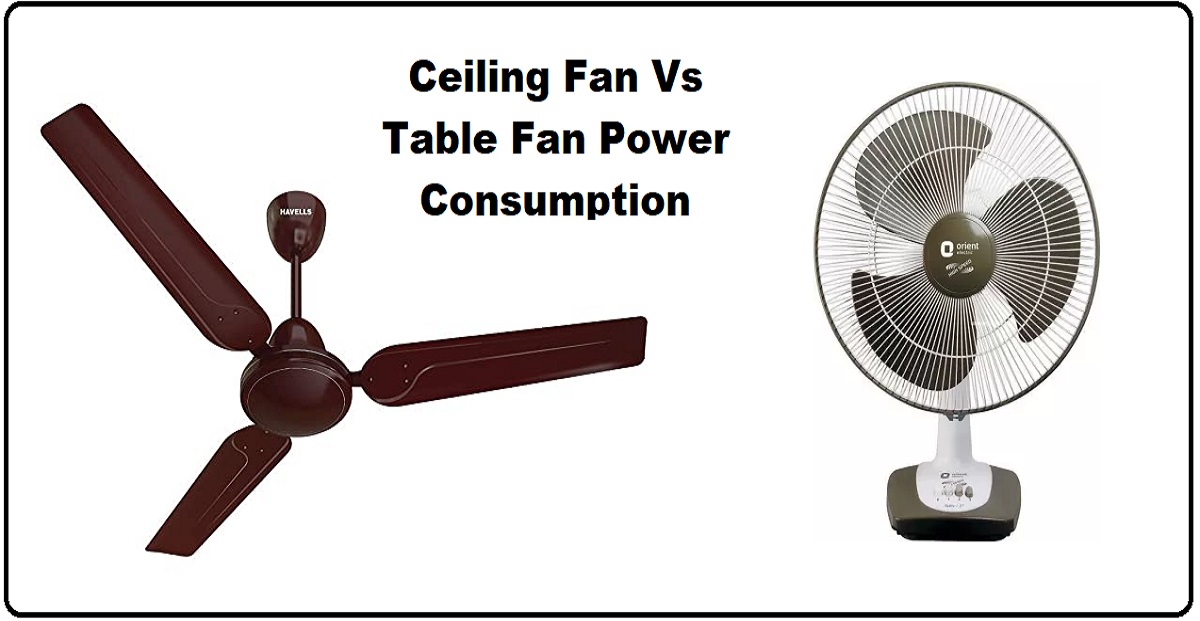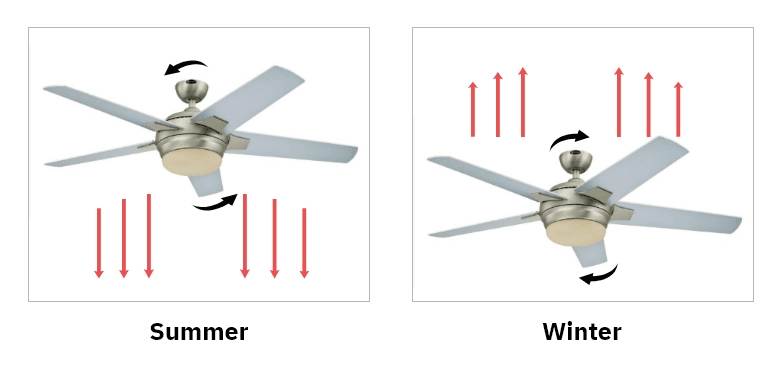Introduction
Remember those sweltering summer days when the only thing standing between you and a heatstroke was a rickety, old floor fan? The constant whirring and the feeling of a gentle breeze were a welcome relief, but at what cost? As we navigate a world increasingly conscious of energy efficiency, the question of whether ceiling fans or floor fans are the more economical choice takes center stage. This article delves deep into the energy consumption battle between these cooling champions, revealing the winner and providing practical tips for saving energy and money.

Image: simpleghar.com
While the answer might seem straightforward, the reality is nuanced. Choosing between a ceiling fan and a floor fan boils down to several factors, including fan size, speed, and usage patterns. In the following paragraphs, we’ll dissect the intricacies of power consumption for both fan types, exploring the benefits and drawbacks of each. We’ll also examine the latest energy-efficient models and offer expert advice to help you make the most informed decision for your energy bill and your comfort.
Power Consumption Basics: The Energy Efficiency Equation
Understanding power consumption requires grasping a few fundamental concepts. Power, measured in watts (W), is the rate at which energy is used. The higher the wattage, the more energy a device consumes. Energy consumption is typically measured in kilowatt-hours (kWh), which represents the amount of energy used over a specific time period. The kilowatt-hour is the standard unit used to bill consumers for their electricity usage. To illustrate, a 100-watt fan running for 10 hours consumes 1 kWh of energy.
Now, let’s dive into the specifics of how much power ceiling and floor fans actually draw:
Ceiling Fans: The High-Flying Energy Savers
Generally, ceiling fans are more energy-efficient than their floor-bound counterparts. This is due to their unique design, which allows them to move larger volumes of air with less energy. A standard ceiling fan typically ranges from 40 watts to 80 watts, depending on its size and features. Some modern models with energy-saving features, like DC motors, can consume even less, dropping to as low as 20 watts.
Another advantage of ceiling fans is their ability to circulate air more effectively. By creating a downward draft, they cool the entire room, whereas floor fans directly target a smaller area. This enhanced air circulation contributes to a more even temperature distribution, making the room feel cooler and reducing the need to blast the air conditioner.
Floor Fans: The Portable Cooling Companions
Floor fans are convenient and portable, making them ideal for small rooms or temporary use. Their power consumption, however, tends to be slightly higher than that of ceiling fans. A typical floor fan ranges from 50 watts to 150 watts, with larger models requiring more power. The energy consumed by a floor fan also varies based on its speed setting, with higher speeds drawing significantly more power.
Despite being less energy-efficient overall, floor fans can be an economical option if used strategically. For example, using a floor fan to directly cool a person rather than an entire room can reduce energy usage. Additionally, modern floor fans are increasingly incorporating energy-saving features like oscillating functions and timer settings, allowing you to customize your cooling needs and maximize efficiency.

Image: alquilercastilloshinchables.info
Factors Influencing Power Consumption
The power consumption of both ceiling and floor fans can be influenced by several factors:
- Fan size: Larger fans typically require more power to operate. Smaller fans, like those often used in bedrooms, consume less energy.
- Fan speed: Higher fan speeds translate to increased power consumption. While a gentle breeze might be sufficient for comfort, running a fan at maximum speed will dramatically increase energy usage.
- Motor type: Modern DC motor fans are known for their energy efficiency, using significantly less power than traditional AC motor fans.
- Fan usage: The longer a fan runs, the more energy it consumes. Smart timers and remote controls can help manage runtime and minimize unecessary energy usage.
- Room size: In larger rooms, ceiling fans are more effective at circulating air and may require less energy to maintain a comfortable temperature compared to floor fans.
Making the Right Choice: Balancing Comfort and Energy Efficiency
Choosing between a ceiling fan and a floor fan should consider several factors beyond power consumption alone.
Choosing a Ceiling Fan
Ceiling fans are an excellent choice when energy efficiency is a priority, and you desire to cool an entire room evenly. They are particularly effective in high-ceiling rooms, as they can create significant air circulation.
- Benefits: Energy efficient, cools entire room, can be integrated with lighting fixtures, adds aesthetic appeal, can be used in conjunction with air conditioning to reduce overall energy consumption.
- Drawbacks: Higher installation costs, limited portability, may not be suitable for certain room types (e.g., low ceilings).
Choosing a Floor Fan
Floor fans shine when portability and temporary cooling solutions are needed. They are also ideal for smaller rooms or for targeted personal cooling.
- Benefits: Affordable, highly portable, can be readily moved from room to room or even outdoors, easy to use and maintain.
- Drawbacks: Less energy-efficient than ceiling fans, can be noisy, may not create as much air circulation, can be an eyesore if left out constantly.
Expert Tips for Energy-Saving Cooling
Regardless of your choice, employing these strategies can help reduce your energy consumption:
- Choose energy-efficient models: Look for fans with Energy Star certification, DC motors, and variable speed settings.
- Adjust fan speed: Utilize lower fan speeds when possible. A gentle breeze is often sufficient for comfort.
- Use a timer: Program fans to run only when needed to minimize unnecessary energy usage.
- Combine cooling methods: During the hottest periods, using a ceiling fan in conjunction with air conditioning can significantly reduce cooling costs while ensuring maximum comfort.
- Maximize natural ventilation: Open windows and doors to allow for natural airflow during cooler times of day.
- Consider shading: Using window coverings or awnings to block direct sunlight can reduce heat gain and minimize the need for fan use.
FAQs about Ceiling and Floor Fans
Q: How many kWh does a typical ceiling fan use per month?
A: A standard 75-watt ceiling fan running for 8 hours a day would use approximately 18 kWh per month.
Q: What is the difference between AC and DC motor fans?
A: DC motor fans are more energy-efficient than traditional AC motor fans. They use less power to operate and are often quieter.
Q: Should I leave my ceiling fan running all day?
A: Leaving a fan running when not occupied is an energy waste. Utilizing timers or remote controls can automatically turn off fans when the room is empty.
Q: Can I use a floor fan while sleeping?
A: While floor fans can provide a cool breeze, they can also be noisy and cause disruptions to sleep. It’s better to use a ceiling fan for nighttime cooling or a floor fan with a sleep mode or quiet setting.
Ceiling Fan Vs Floor Fan Power Consumption
Conclusion
In the battle for energy efficiency, ceiling fans often emerge as the victor, offering a more economical cooling solution than floor fans. However, floor fans remain valuable for their portability and targeted cooling capabilities. The best choice ultimately depends on your individual needs and preferences. By understanding the factors that influence power consumption, incorporating energy-saving practices, and carefully considering your cooling needs, you can make an informed decision that saves energy, money, and keeps you comfortable throughout the year.
Are you interested in exploring other aspects of energy efficiency in your home? Let me know your thoughts in the comments below and I’ll be happy to share more tips and advice in future posts.






